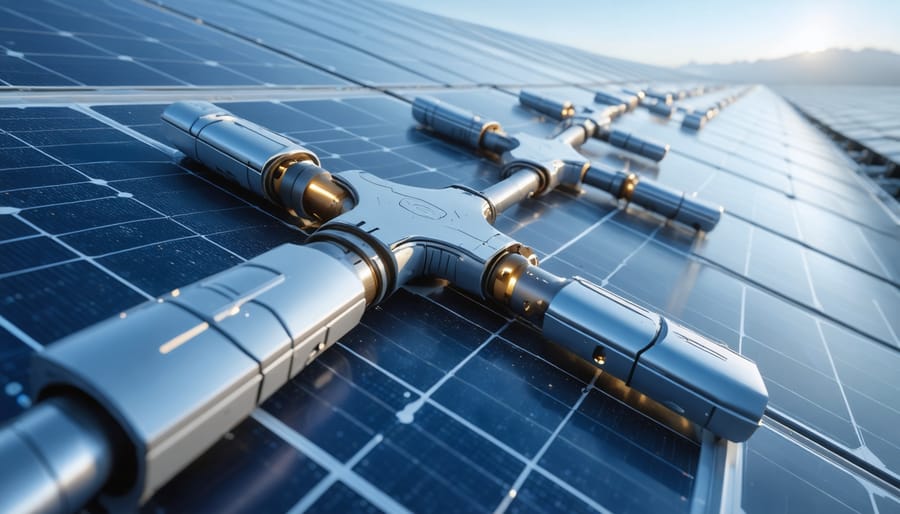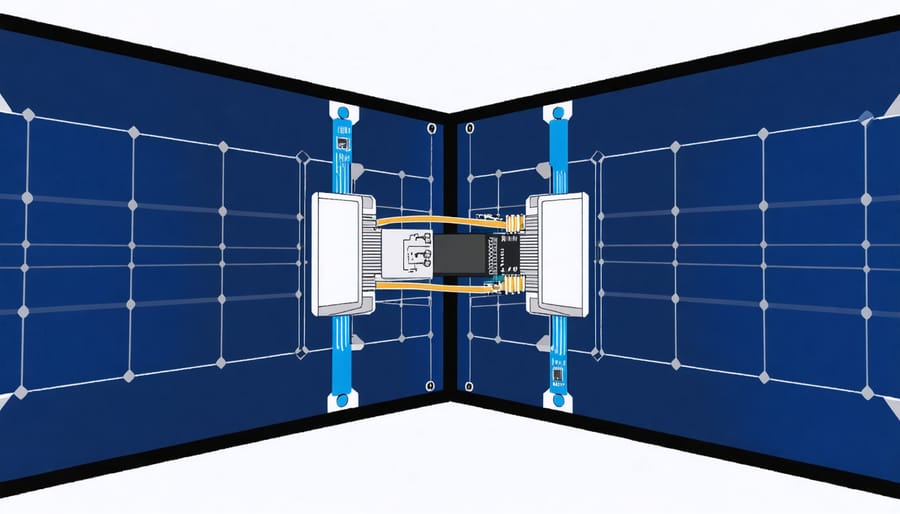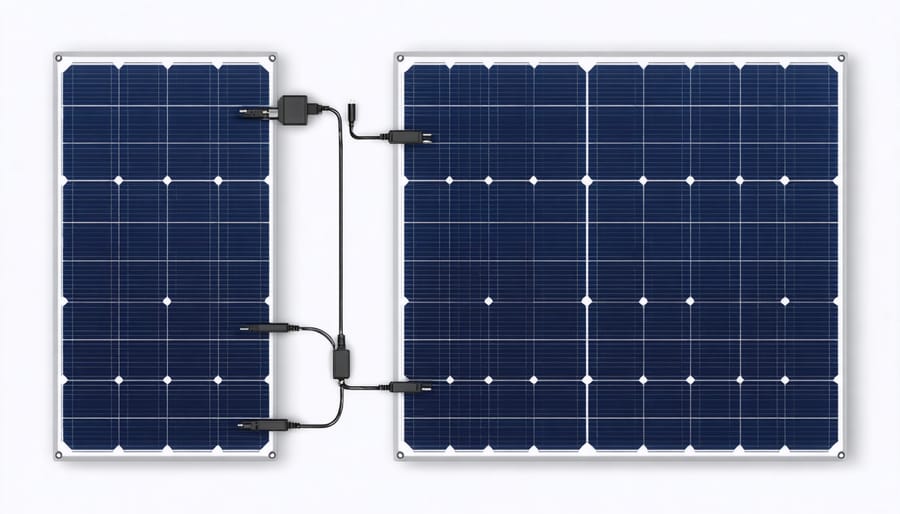Solar Panel Y Connectors: The Smart Way to Boost Your System’s Output

Solar panel Y connectors revolutionize the way we harness and distribute solar energy across modern photovoltaic systems. These essential components enable parallel connections between multiple solar panels, maximizing power output while maintaining system flexibility and reliability. By splitting or combining DC current paths, Y connectors serve as crucial integration points in both residential and commercial solar installations throughout Europe, where renewable energy adoption continues to accelerate.
As a fundamental building block in solar array architecture, Y connectors offer installers and system designers the versatility to optimize panel arrangements, enhance power collection efficiency, and simplify maintenance procedures. Their robust construction, typically featuring weatherproof materials and gold-plated contacts, ensures consistent performance under diverse environmental conditions while meeting stringent European safety standards and regulations.
Whether upgrading existing installations or planning new solar projects, understanding Y connector specifications and implementation strategies remains crucial for achieving optimal system performance and long-term sustainability.
Understanding Solar Panel Y Connectors
Components and Construction
A solar panel Y connector consists of several essential solar panel components designed for optimal performance and durability. The main body is typically constructed from high-grade, weather-resistant plastic or reinforced polymer materials that ensure longevity in outdoor conditions. The connector features three terminals: one input and two outputs, forming the characteristic Y-shape that gives it its name.
The internal wiring comprises high-conductivity copper or tinned copper strands, protected by double-insulation layers for enhanced safety. Most modern Y connectors include robust MC4-compatible terminals with spring-loaded safety locks, ensuring secure connections even in challenging weather conditions. The housing incorporates watertight seals and UV-resistant materials, achieving an IP67 or higher protection rating for reliable outdoor performance.
Quality Y connectors also feature polarised connections to prevent incorrect installation, while internal diodes protect against reverse current flow, enhancing system efficiency and safety.

Types of Y Connectors
Solar panel Y connectors come in various configurations to suit different installation requirements and system specifications. The most common types include MC4 Y connectors, which are widely used across Europe for their reliability and standardised compatibility. These branch connectors typically feature either 1-to-2 or 2-to-1 configurations, allowing for parallel connections of solar panels or strings.
When selecting Y connectors, it’s essential to consider the amperage rating, which commonly ranges from 20A to 40A for residential installations. Premium models often incorporate IP67 or IP68 waterproof ratings, ensuring durability in various weather conditions. Some manufacturers offer gender-specific variants – male/female combinations – to accommodate different system designs.
For larger installations, heavy-duty Y connectors with enhanced current capacity and reinforced insulation are available. These models often feature additional UV protection and flame-retardant materials, making them suitable for industrial applications. Compatibility with existing connectors is crucial, as mixing different brands or types can compromise system safety and warranty validity.
Benefits of Using Y Connectors
Y connectors offer numerous advantages that make them invaluable components in solar panel installations. First and foremost, they enable efficient power combining from multiple solar panels, maximising the energy harvest from your solar array. This capability is particularly beneficial for European installations where space optimisation is often crucial.
These connectors significantly enhance system flexibility by allowing parallel connections of solar panels with matching voltage specifications. This arrangement helps maintain consistent power output even when some panels are partially shaded or operating at different efficiency levels, ensuring more reliable energy production throughout the day.
From an installation perspective, Y connectors simplify the wiring process and reduce the overall number of components needed. This streamlined approach not only saves time during installation but also minimises potential points of failure in the system. The reduced complexity translates to lower maintenance requirements and improved system longevity.
Cost-effectiveness is another key benefit, as Y connectors eliminate the need for additional junction boxes or combiner boxes in certain configurations. This reduction in components not only decreases initial installation costs but also reduces long-term maintenance expenses.
For system upgrades, Y connectors provide excellent expandability options. They allow for easy integration of additional panels to existing installations, making them ideal for growing energy needs. This scalability feature is particularly valuable for both residential and commercial installations where energy demands may increase over time.
Installation and Safety Guidelines

Installation Best Practices
When preparing to install your own solar panels, proper Y connector installation is crucial for system efficiency and safety. Begin by ensuring all components are clean and dry. Position the Y connector away from direct exposure to rain and intense sunlight, ideally under the solar panels themselves.
First, disconnect the main power supply and verify zero current flow using a multimeter. Strip the cable ends carefully, maintaining precise lengths according to the connector specifications. Insert the cables into the Y connector terminals, ensuring proper polarity matching (positive to positive, negative to negative).
Secure connections by tightening the terminal screws to the recommended torque – typically 2.5-3 Nm for most models. Apply weatherproof sealant around cable entry points to prevent moisture ingress. Double-check all connections before restoring power, and monitor the system performance for the first few hours of operation.
Remember to document your installation configuration and maintain regular inspection schedules for optimal performance and longevity.
Safety Considerations
When working with solar panel Y connectors, safety must be your top priority. Always ensure proper solar system grounding to prevent electrical hazards. Before installation or maintenance, completely disconnect the solar system and verify zero voltage across all connections using appropriate testing equipment.
Never attempt to connect or disconnect Y connectors while the system is under load, as this can cause dangerous arcing. Use only compatible connectors from reputable manufacturers, and ensure they match your system’s voltage and current specifications. Check that all connections are weatherproof and properly sealed to prevent moisture ingress.
Wear appropriate personal protective equipment, including insulated gloves and safety glasses, when handling connectors. If you notice any signs of damage, discoloration, or loose connections, replace the Y connector immediately. For complex installations or modifications, always consult a certified solar installer to ensure compliance with local electrical codes and safety standards.
Maintenance and Troubleshooting
Regular maintenance of Y connectors is essential for ensuring optimal performance and longevity of your solar installation. Inspect connections quarterly for signs of oxidation, loose fittings, or physical damage. In coastal areas or regions with high humidity, more frequent checks may be necessary due to increased corrosion risk.
Common issues include connection loosening due to thermal cycling, moisture ingress, and degradation of connector insulation. If you notice any discoloration, melting, or brittleness of the connector housing, immediate replacement is recommended. Poor connections can lead to voltage drops and reduced system efficiency.
When troubleshooting, first ensure all connections are clean and properly tightened to the manufacturer’s specifications. Use a multimeter to verify equal voltage across parallel branches. Uneven readings might indicate a faulty connector or mismatched panels. If you detect unusual heating during operation, this could signal a poor connection requiring immediate attention.
For maintenance, clean connections with appropriate electrical contact cleaner and ensure protective caps are properly seated when not in use. Apply dielectric grease to prevent moisture-related issues, particularly in outdoor installations. Keep detailed maintenance records, noting any repairs or replacements for future reference.
If you’re unsure about any maintenance procedures, consult a qualified solar installer. Professional inspection during annual system maintenance can help identify potential issues before they affect system performance.
Y connectors play a vital role in modern solar installations, offering flexibility and efficiency in system design while maximizing power output. Throughout this guide, we’ve explored how these essential components enable parallel connections between solar panels, enhance system reliability, and provide cost-effective solutions for both residential and commercial installations across Europe.
When selecting and implementing Y connectors in your solar project, remember to prioritize quality and compatibility with your existing system components. Always choose certified products that meet European safety standards and ensure professional installation to maintain system integrity and longevity.
For optimal results, we recommend working with qualified solar installers who understand local regulations and can properly integrate Y connectors into your solar array. Regular maintenance and inspection of these connections will help prevent potential issues and ensure sustained performance of your solar investment.
As the European solar market continues to grow, Y connectors remain fundamental to creating efficient, scalable, and sustainable energy solutions. By following the guidelines and best practices outlined in this article, you can confidently incorporate Y connectors into your solar installation while maximizing both safety and energy production.
Leave a Reply